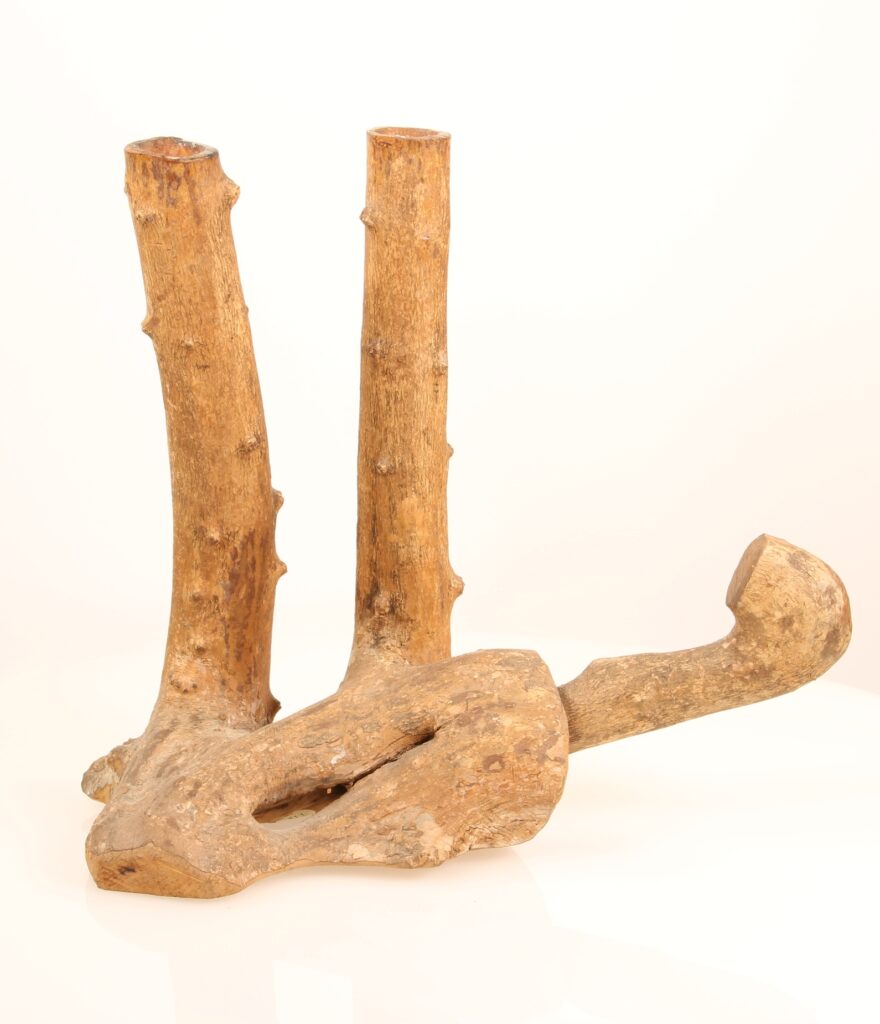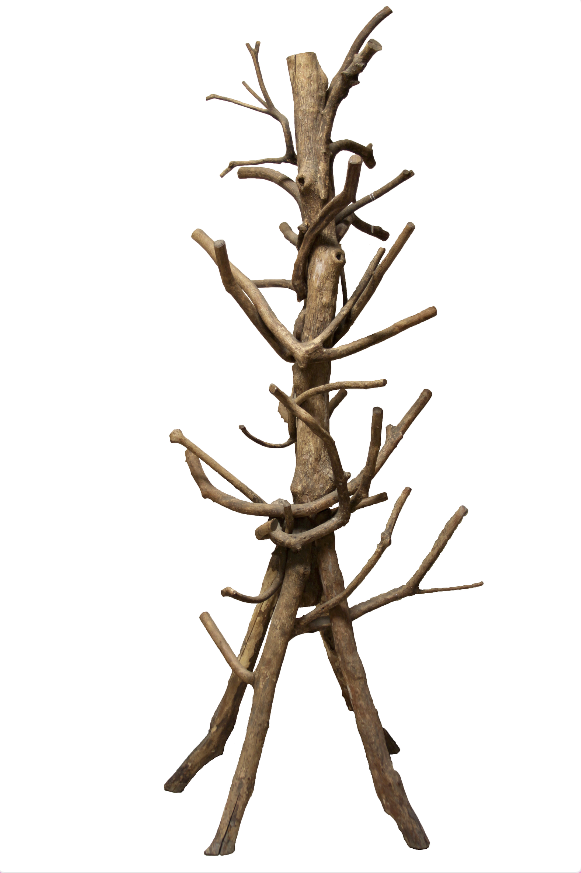“I find that while in the mood of idleness memory amuses me, in the mood of energy hope cheers me… I believe that all men’s lives are compounded of these two moods in various proportions, and that this explains why they have always, with more or less of toil, cherished and practiced art.â€
— William Morris, “The Aims of Artâ€
A self-portrait by the Reverend Howard Finster, painted on plywood and stuck to a scrawled-on base, lies somewhat irreverently tipped onto its side on a top shelf in the storage room of Berea College’s Loyal Jones Appalachian Center. “It’s an interesting piece,†the Center’s curator, Christopher Miller, told me on a tour through their holdings, “but I don’t really know what to do with it. We don’t have much ‘folk art’ here.†Instead, what the Center has – what’s keeping the Finster company on its shelf – is coke bottles and carvings, wooden dolls and dulcimers, candle sticks, coat racks, woven baskets, metal cans, quilts and coverlets, handmade brooms, rock chunks, motherboards, lead paint, typewriters, and a godless, gaudy Dolly Parton pinball machine, all things that have been made in or about Appalachia.
Considering the esteem in which the art world has long held Finster, it was instructive to see a work of his denatured, or maybe renatured, as a part of this miscellany. It seemed stripped of all its artiness by proximity to stuff which, like it, was made with few pretensions beyond those of personal indulgence or economic necessity – stuff made either “in the mood of idleness†or “in the mood of energy.†It seemed contextualized, its admonitions (“DONT PUT GOD OFF TO LONG HE LOVES YOU ALL [sic]) more earnest than I’ve encountered them in other Finsters.
But that’s likely a bit romantic. Miller told me that Berea College, situated on eastern Kentucky’s western edge, started becoming a hub for the study and preservation of Appalachiana in the very late 19th century. Its then-president William Goodell Frost noticed that locals were beginning to lose interest in making the things they’d been making for as long as anyone could remember. With the steady spread of mail-order catalogs into America’s furthest reaches, rural folks everywhere in this period started to gauge their time better spent not quilting or carving, at least for survival’s sake, and instead just buying from Sears. Bourgeois dispositions like Frost’s were, in America as in England, offended by what they felt was a “determination†(in William Morris’ words) of “civilization [to] brutalize the crafts of life by cutting them off from the intellectual part of us.†So, the very cultural arbiters of this determination – politically progressive college presidents-cum-philologists, for instance: America’s cresting elite – set to sublimating it. In England, the result was the Arts and Crafts Movement; in Kentucky, it was Frost collecting coverlets and urging the Appalachians to go on making them. It’s to Frost, then, that we owe not only the seeds of Berea’s interesting collection, but also the interpretive tension we’re set with in appreciating it: the tradition many of these objects imply was actually always somewhat bespoke.

The entire category of American Folk Art, from Freake Limner through Lonnie Holley, has long been confused in a similar direction. Practically every work that comprises this meta-genre is an oddity from the nascence of America’s popular or consumer culture, or else a confrontation between developed mass culture and one amorphous local trend or another, rather than an example of some coherent regional or ethnic group’s stylistically consistent cultural production. Many artists from the Appalachian region, Finster chief among them, have contributed significantly to this canon, but it would be tough to identify much that’s distinctly Appalachian about their works, at least in a stylistic sense. (This isn’t to say, of course, that aspects of Appalachian life haven’t contributed to the development of certain individual artistic personalities, but that is an altogether different issue.) The problem we’re confronted with in Berea’s collection is related but subtler. Much of what can be said to belong to an Appalachian style does so by virtue of having been made, wittingly, to be “Appalachianâ€: woven grass baskets, optical coverlets, furniture, etc., all channeling more than expressing the essence of mountain life. Like many of the fetishes that shook Picasso at the Trocadéro, these are things whose authenticity is more a market phenomenon than it is some völkisch residue.
Invariably, these artifacts are important reflections of the region’s collective identity formation throughout the last century. The most delightful objects held at the Center, however, belong to an adjacent category. Disparate, these latter items don’t distinguish themselves through reference to a matrix of formal concerns – as would an artifact that is a great example of some particular aesthetic tradition and compels us insofar as it is exemplary – but rather by the singularity with which the “moods†(in Morris’s sense) of their makers remain palpable in them. These things are only really Appalachian in that they were made in Appalachia; their formal characteristics suggest tastes and concerns that are individualistic before they are regional. These are the Center’s uncut gems, masterpieces of a rugged idiosyncrasy.
One example is the assortment of nine whittled doodads that a former Berea professor collected a few decades ago on a trip through eastern Tennessee. Driving along a backroad, he came across a storefront or a stoop where a group of old dudes was shooting shit and carving. What they were making was nothing, essentially: dowels, slightly longer than an outstretched hand, carved into repeating, slightly oscillatory geometrical forms. They look like miniature banisters or decorative drumsticks. The best of the nine is a stack of spheroids, all barely clipped so as to be vaguely prismic. It begs fondling; it was made to be handled, so much so that just looking at it is almost a haptic experience. The nine trinkets are pure idleness, their rhythms are those of idle chatter. It’s evident that they were made in the throes of very little at all, the cool results of almost no expenditure. It’s as though they’re the rivulets of an eased unconscious made tangible. They are talismans of killing time.
Another example is a group of candlesticks made from found wood. The most arresting has two bumped prongs where the candles go, a thick gnarled base, a handle, in light brown. It stands maybe a foot and a half high and is about two feet long. Its allure mostly lies in its absolute seamlessness: it is almost impossible to tell what of it was carved, and what remains unaltered from the day it was yanked off the forest floor. One of its shafts – the one closer to the handle – juts straight up, while the other lists slightly forward, giving the whole thing an air of movement that feels almost personified. But it is thoroughly abstract. The base diffuses terrestrially as soon as the shafts terminate into it, angling upwards towards the handle in counterpoint to the forward shaft’s tilt. There’s a narrow hole in its middle that’s an almost perfect mirror of the handle, which protrudes out the back. Though it curves ergonomically, the handle is stolid and arboreal, almost entirely natural in appearance, which makes its evident facture seem, paradoxically, thoroughly a part of the object’s otherwise totally aleatory character. Genreless, this candlestick is a work of ingenious appropriation.

One final instance of an object from Berea’s collection that asserts this singularity of style is a coatrack made from wild rhododendron. Four slightly curved tree parts have been joined at their tops to form its base, while up from these a straight one shoots high to make its body. Off of this, dozens of branches, affixed with nails, poke in every direction. Though these are all from the same species as their support, they’ve been added to it with a frequency and a ferocity that alienates them from it. The result is not only a busyness that undercuts entirely the piece’s functionality – a garment would get torn up in there – but a sense that this thing’s maker was trying to outdo nature on its own terms. If there’s an art historical referent, it’s analytical cubism, whose just-so planes in tenuous arrangement were meant to signify the simultaneity of multiple optical perspectives in our perception of an object, as well as multiple moments in an event’s unfolding. The coatrack’s stabbing parts seem similarly to be trying to convey every aspect of their medium’s being: the rhododendron’s violent angulation, the way it sways in the breeze and crumples when chopped.
It would be difficult to locate in these three examples (not to say the many others of their ilk kept by the Loyal Jones Appalachian Center) much that can be said to be distinctively Appalachian. To do so would be to essentialize their shared proclivities for natural materials, rough textures, and organic forms – traits common to handicraft from any place whose social character is shaped by remoteness, privation, and proximity to biodiversity – into a rather circumscribed typology. In fact, their firmest commonality is precisely their incommensurability, their failure to cohere into a style. (This mark of their makers’ resolute independence speaks, if to anything, then to these objects’ general Americanness.) The crazy rhythms of the coatrack hardly square with the contemplative repetitions of the rods, which are far more strictured than the organicity of the candlestick, and so on. Aside from contributing to their strange power in an aesthetic sense, this incommensurability could help us better understand the categories into which these objects resist falling, namely “Appalachian†and “Folk†art. The former, as I’ve said, has historically subsisted on reified notions of authenticity and tradition that, paradoxically, belie their own constructedness. The latter, similarly, results from the confused application of an ethnological term to modern problematics of mass culture which it is ill-equipped to describe.
Our appreciation of the masterpieces from the canon of American Folk or Outsider Art – works like the Center’s Finster – is due in part to their bringing to a point of overbrimming the contradictions inherent in our notion of tradition. Typically, they do so by mirroring mainstream visual techniques, but in unexpected and often perverted ways. Our unwillingness to call them fully modern compels us to align them with some sort of tradition, with which they flirt but which they ultimately rebuff. Our pleasure in experiencing them, therefore, derives from something like a taxonomic sublime. In terms of our experience, the operations of the objects from the Loyal Jones Appalachian Center which I’ve described are identical but for one important difference: they convince us that they participate in no visualities apart from their own. (The difference is analogous to that between the postmodern and the modern approach to an artwork’s meaning and effect.) This transcendence of style – regardless of whether it is actual or simply apparent – is the mark not just of interesting artifacts, but of great works of art.
Top image: Wooden dowels carved by an unknown group of stoop-sitting men in Eastern Tennessee in the mid-20th century. Image courtesy of the Loyal Jones Appalachian Center.
UnderMain: On the Road sends writers out of Kentucky to explore the visual arts in cities of the Midwest and near South. This program is generously supported by the Great Meadows Foundation.




